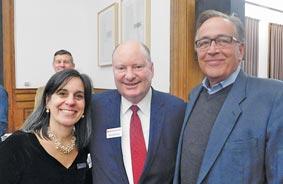
11 minute read
Condo Lifestyles State of the Industry


Advertisement
201 9 stat e industry CHICAGO CULTURAL CENTER / DECEMBER 12, 2019 o f the

PREMIERE SPONSOR Xfinity Communities
MAJOR SPONSORS Belfor Property Restoration Community Specialists Dickler, Kahn, Slowikowski & Zavell, Ltd. Elara Engineering Keough & Moody P.C. Kellermeyer, Godfryt & Hart, PC Klein & Hoffman LMC Construction

David Barnhart & Shruti Kumar The Habitat Company Tony Briskovic Chicagoland Community Management Tairre Dever-Sutton Tairre Management Michael Donnell, Marla Jackson & Bill Southall FirstService Residential Natalie Drapac, Molly Trogdon Community Specialists Gail Filkowski First Community Management 2019 STATE-OF-THE-INDUSTRY COMMITTEE
Northern Illinois Fire Sprinkler Advisory Board(NIFSAB) Wintrust Community Advantage Worsek & Vihon, LLP
Tom Skweres ACM Community Management William Townsell Chicago Police Dept. Derek Wilkinson Associa Chicagoland

enhancing landscapes for life … enhancing landscapes • Landscape Maintenance • Landscape Design/Build • Landscape Construction • Seasonal Flower Rotations • Snow and Ice Control

708.926.2304 gsemmer@semmerlandscape.com
moved and organized and disrupting everybody’s day-to-day living is the greater difficulty. Also, I have found on larger buildings having a project manager who can keep everything moving is huge. It is very difficult to ask an onsite management staff to take on a riser rehabilitation and replacement project in addition to their day to day activities. They don’t generally have the bandwidth to do that.
Q: Pete, when you’re looking to assist associations finance these projects, what can boards do to help you through that process and vice versa? Santangelo: When communicating with the unit owners, make sure they understand how intrusive the projects going to be. From the banking perspective, it’s working with professionals to make sure we are structuring a sound finance project.
Q: How can you structure financing for a project that extends over many years? Santangelo: We’re kind of flexible, and it’s really communicating with us and the board as to what cash flow resources they are going to set up for repayment of the loan. It depends on how they are structuring their repayment, whether they are paying for it out of their operating budget or contribution to reserves or implementing a special assessment.
Q: What’s happening with interest rates? Santangelo: Rates are still good. I wish I could say the same on the CD side, but on the loan side if you are looking to do a project, your rates are still very low.
Q: Matt, what are the current issues in regard to property taxes? Matthew Panush: It has been a very uneven ride lately. We have a new assessor in Cook County for 2019. He just wrapped up his first reassessment—the north end of the county, the northeast and northwest suburban Cook County. We saw values on residential properties that stayed the same, values that were reduced and values that were much higher. In some places, residential condominiums were increased by up to 325 percent. Overall, I think residential properties got a fair shake, but there was a lot of correcting to be done. As they went through some of the issues they were having, more relief was granted on appeal at the assessor’s level than they had in the past and rightly so. How the appeals will turn out, we probably won’t have answers until spring of 2020. Dickler: Every one of you should hire an attorney who does the work of appealing property taxes. The attorneys do this almost universally on a percentage basis of the savings, so there is nothing out of pocket for an association. It’s a no-lose proposition. If you’re the board and you don’t do it, I think you’re facing Boucher claims under the Michael Boucher v. 111 E. Chestnut Condominium Association case. Management, you’d better be putting in writing that your associations should do that. Then if they don’t, you’re off the hook as far as I’m concerned on the management side. Do not assume just because you raised it at a meeting and told them it’s their decision that you are protected that way.
Q: Marshall, in regard to the changing environment for service animals, what are some nuggets of advice? Dickler: The changes in the statute are minute, but they are very, very important. I think there will be a lot of litigation on service animals. Both the state and the federal government are going to be dealing with and controlling it more and more because it’s pretty outrageous. Everybody just sends off to and gets a letter from this person who is on the internet and they sign it and you send them $100 or $50 bucks. I’m hoping this is going to go away. The question about whether people have a personal and professional relationship with this person and are treating them? They say they can do it on the internet or Skype. I’m not sure that is completely going to go away. Get a manager and get an attorney, and get their advice and follow it. Management should push


Q: With the legalization of cannabis coming, what can you tell associations about how odors move through a high rise and what can be done about it? Sanders: We have worked in several high rise buildings to try to mitigate odors, and it’s never been 100 percent successful, mostly because odors don’t necessarily go with air flow. They go from an area of high concentration to an area of low concentration. The air flow kind of helps allow the odor to not go in that direction, but it doesn’t stop it. Once it gets into the corridor, it spreads throughout the floor. You can try to seal up that unit, you can try several things but you also have the human factor. If someone opens a window, that immediately changes the pressurization in the building. You also have things like stack effect this time of year where on the bottom half of the building air wants to come in, and on the top half of the building air wants to go out. If somebody on the bottom half of the building is making an odor and you can’t contain it, it’s going to easily spread up in the building. It’s a very difficult thing to mechanically combat.
Q: Dave, how do your buildings hold a unit owner accountable for creating offensive odors? Barnhart: Wherever possible, we like to have a third party other than the person who is experiencing the odor to verify that odor exists. This tends to be a late-day problem. It tends not to be an early morning problem. Most of the larger high rises tend to have a security detail in effect particularly on the overnight shifts. Most governing documents have a clause about noxious and offensive activities, and associations have a process in place to enforce those rules.
Q: Howard, what can a board do to try to get ahead of the problem of cannabis odors? Dakoff: Most clients are on a wait-and-see mentality. If you have a building that has smokers and you can smell it in the hallways, you are probably still going to smell it. They’ll just have no fear they are violating the law. If you have a building that the composition of the owners is such that you’ve never smelled it, I don’t know that you will suddenly have a systemic problem. The cannabis statute allows a condominium board to amend its governing documents to prohibit the smoking of cannabis in the units. I didn’t say ‘vaping.’ There is a legal difference between vaping and smoking in terms of the statute. You cannot prohibit cannabis vaping in the units. You can prohibit vaping in the common elements. Your main legal remedy is to do an amendment to the declaration to prohibit smoking of cannabis in units. That does not mean if you don’t adopt an amendment, you have no remedies. If you do nothing, you’re in the same boat as you are with migration of regular cigarette smoking today. If you can identify the unit and you have an owner complaining about a noxious or offensive activity, the fact that smoking cannabis is legal or illegal doesn’t matter, you have the whole enforcement process to follow for noxious and offensive conduct. That said, if you are looking for a very clear way to address it, it’s an amendment to the declaration to prohibit smoking in the unit. Dickler: Cannabis is still illegal federally. You might be able to bring an action because of federal law. If you don’t do anything, we are back to my concern someone can sue the board and management for allowing a federally illegal act on the property. We don’t have a good answer right now other than we are telling people don’t ignore it. We think at the very least, have rules in place before somebody out there becomes a problem. We are seeing the amendments to declarations to eliminate cannabis in any form possible to proactively try to get rid of it. We have to think about someone putting cannabis in cookies and giving them to a neighbor or leaving them out for Trick or Treat. It happens every Halloween.
Q: Does any of this apply to people who are smoking marijuana for medical reasons?
Dickler: Federal law is the federal law. You can prohibit it in your building at this point. If


someone tells me you are not providing an accommodation under the FHA, you’re dealing with another Act. The question becomes which Act controls? At this time and the fact that it is still federally illegal and the fact that you’ve amended your declaration to prohibit smoking, I think it’s going to work. There are other ways you can use medical marijuana, so you are not prohibiting the medical treatment.
Q: Could you talk about the changes in FHA regulations for residential purchases? Santangelo: There are several changes I found

that affect condominium associations. The first is spot approval. If your building is not FHA-insured, but you have a buyer who wants to use an FHA loan, FHA will do a one-off or spot approval. If an association has 10 or more units, units may be eligible for spot approval if no more than 10 percent of the units are FHA-insured. If the building has fewer than 10 units, no more than two units can have FHA financing. When your building was approved, you had to recertify every two years. Now it’s every three years. For condos with commercial units, the nonresidential space limit was set at 25 percent; that has been increased to 35 percent. Owner-occupancy was reduced to 50 percent.
Q: Dave, you are also a real estate broker. Are you seeing any changes in property valuations based on this change? Barnhart: I think it’s a little too soon. The effective date for these changes was October 15. I don’t think the brokerage community as a whole has had a chance to digest all these changes. If you think about how many associations have commercial space on the entire streetscape and units on just two floors above, almost all that type of housing was ineligible for FHA financing in the past. Now almost all of it is eligible. For credit-worthy first-time buyers, this is a huge plus, but it will take the real estate community to know how to steer buyers in the right direction and use FHA financing.
Q: The City of Chicago recently passed an ordinance that increased the percentage of owners who must approve a de-conversion from 75 percent to 85 percent. Howard, what effect will that have on the de-conversion trend? Dakoff: The ordinance won’t stop all de-conversions, but it may require buyers to offer a little more financial incentive to get to the 85 percent vote. The opinion of our firm is the number you should be concerned about is far less than that. You should be concerned with the number of units in your building owned by a single entity. If an investor buys as few as 10 percent of your building, that can disrupt your condominium association. It could affect the association’s insurability and whether lenders will make loans for potential buyers. We have seen buildings have a complete stall of resale units because no one wants to buy into a building that is perceived to be under a hostile takeover. If no one can sell their units, prices start to drop (if they can sell at all) or the only buyer in town is this developer. There have been a couple of high profile newsworthy hostile takeovers in Chicago. If you think your building is vulnerable, you can take defensive postures. You can adopt leasing restrictions and unit owner restrictions. For example, no more than X-percent of the units can be leased. That might not fit into the business plan for a developer who wants to buy up the building slowly but has to leave his units vacant and can’t earn money by leasing them out. You can also adopt an amendment that says no owner can own more than a certain percent of the units in an association.
Q: How are drones being utilized in capital projects? Bonick: Drones are great for looking at roofs and getting property overviews of large properties in the suburbs and in places where you don’t have high winds and all kinds of other highrises surrounding it. Another thing is you can’t actually touch anything with a drone yet. You can’t get up there and remove a spall from your concrete facade, and you can’t caulk a window. YET. Y








